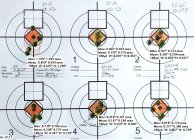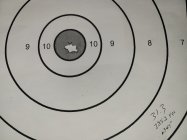You are using an out of date browser. It may not display this or other websites correctly.
You should upgrade or use an alternative browser.
You should upgrade or use an alternative browser.
Weird primer strikes
- Thread starter Texas Solo
- Start date
Texas Solo
B.S. High Master
20 on that day. Rifle has 500 on it.How many rounds did you shoot? How did they shoot? Looks to be a slight crater in one of them. Was the barrel recently cleaned? Maybe back off the powder a little and see how they shoot.
Load is NOT hot. Shoots sub 1/2 moa at 300yds. My barrels are always clean.
Alex Wheeler
Site $$ Sponsor
Dont take my word for it.Right...with ya on that. Not sure this applies to what you're saying but this isn't hydraulics though. If I hit a nail on the pointy end or the head with the same energy, I believe the same energy gets applied. Not psi but force.
Not trying or wanting to argue, especially about semantics but I did address that by say NOT psi. I get that.Force = PSI [pressure per square inch] X area
So, the pressure is really high on the pointy end of that nail -hence the deformation of the tip.
My point about the nail and this not being hydraulics, the same point I'm making could be said using a press. If I'm pressing two pieces apart, does it matter which end of the rod I'd use in between is up or down? No.
Does a compressible spring make a difference? I'm just thinking out loud, not looking for an argument
Alex Wheeler
Site $$ Sponsor
We are not hitting the firing pin with a hammer. We are hitting it with a pressure vessel. This is the same reason theres more bolt thrust with larger case head diameters. Another example is Kelblys offers two firing pin diameters. The larger one craters primers. Everything else including the clearance is the same.
Last edited:
jelenko
Gold $$ Contributor
So, since the pressure is the same is both cases, the force on the larger pin tip is going to be greater than the force on the smaller pin tip.hitting it with a pressure vessel
Just to clarify, yes there will be more psi to a small tip, all else equal. That was not my previous point.So, since the pressure is the same is both cases, the force on the larger pin tip is going to be greater than the force on the smaller pin tip.
My point was in regard to the energy to drive the pin BACK out of the fp hole, allowing flow, aka crater/blank. That energy is not dependent upon tip diameter, hence my hammer and nail reference. A larger tip displaces, stretches and weakens more material than a small tip. That's all. I'll leave this alone from here
jelenko
Gold $$ Contributor
Actually, the energy is dependent on the area of the tip.Just to clarify, yes there will be more psi to a small tip, all else equal. That was not my previous point.
My point was in regard to the energy to drive the pin BACK out of the fp hole, allowing flow, aka crater/blank. That energy is not dependent upon tip diameter, hence my hammer and nail reference. A larger tip displaces, stretches and weakens more material than a small tip. That's all. I'll leave this alone from here
As Alex mentioned, the psi is the same in both cases. Because the tip of the smaller pin is smaller, there's less area that the pressure has to work on. As mentioned, F = psi X area. With psi being the same and the area being less, the force is less. Energy is transferred through the force being applied over some distance.
The reason I asked if it was recently cleaned is you said that problem was in the 1st three rounds, the rest were shot normal. Sometimes there is leftover residue in the barrel. I thought that could have been the problem. I shoot a 6BR. Whenever I clean my rifle, I wet and dry patch with straight alcohol to make sure there is nothing in the barrel. Squeaky clean and dry.20 on that day. Rifle has 500 on it.
Load is NOT hot. Shoots sub 1/2 moa at 300yds. My barrels are always clean.
Well, going with the CCI-450's worked out pretty well on my virgin Alpha brass. . . surprisingly well for virgin brass.20 on that day. Rifle has 500 on it.
Load is NOT hot. Shoots sub 1/2 moa at 300yds. My barrels are always clean.
The other groups I was testing Remington 9.5's to see if they would do any better than my initial trial. They didn't! Those Remington's just don't work well.

Texas Solo
B.S. High Master
Well, going with the CCI-450's worked out pretty well on my virgin Alpha brass. . . surprisingly well for virgin brass.As you might recall, I had 3 pierced primers out of 10 with the 400's and chronograph data target was poor. See pic below target's 1& 4 for the two 5 round groups (chronoed 10 rounds).
The other groups I was testing Remington 9.5's to see if they would do any better than my initial trial. They didn't! Those Remington's just don't work well.
View attachment 1548261
I'm getting it trued & bushed.

Actually if you think about it a bit (what it takes to back up the firing pin) more, the spring, FP and cocking piece are the same weight for large and small tip, and the amount of force applied is equal to the area of the tip in square inches times the pressure in PSI....so the difference in force applied against the inertia and spring pressure is proportional to the difference in the squares of the radii of the tips. Comparing the extremes, a .075 tip to my Viper's .062, the smaller one has 68% of the area of the larger one, so if the PSI is the same, the force applied to the FP assembly would vary by the same percentage.Just to clarify, yes there will be more psi to a small tip, all else equal. That was not my previous point.
My point was in regard to the energy to drive the pin BACK out of the fp hole, allowing flow, aka crater/blank. That energy is not dependent upon tip diameter, hence my hammer and nail reference. A larger tip displaces, stretches and weakens more material than a small tip. That's all. I'll leave this alone from here
Last edited:
Similar threads
- Replies
- 69
- Views
- 3,258
- Replies
- 19
- Views
- 1,997
- Replies
- 12
- Views
- 1,656
Upgrades & Donations
This Forum's expenses are primarily paid by member contributions. You can upgrade your Forum membership in seconds. Gold and Silver members get unlimited FREE classifieds for one year. Gold members can upload custom avatars.

Click Upgrade Membership Button ABOVE to get Gold or Silver Status.
You can also donate any amount, large or small, with the button below. Include your Forum Name in the PayPal Notes field.
To DONATE by CHECK, or make a recurring donation, CLICK HERE to learn how.

Click Upgrade Membership Button ABOVE to get Gold or Silver Status.
You can also donate any amount, large or small, with the button below. Include your Forum Name in the PayPal Notes field.
To DONATE by CHECK, or make a recurring donation, CLICK HERE to learn how.









